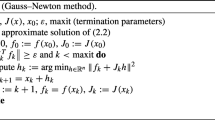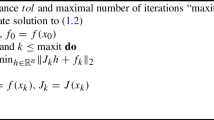Abstract
The Total Least Squares solution of an overdetermined, approximate linear equation \(Ax \approx b\) minimizes a nonlinear function which characterizes the backward error. We devise a variant of the Gauss–Newton iteration with guaranteed convergence to that solution, under classical well-posedness hypotheses. At each iteration, the proposed method requires the solution of an ordinary least squares problem where the matrix A is modified by a rank-one term. In exact arithmetics, the method is equivalent to an inverse power iteration to compute the smallest singular value of the complete matrix \((A\mid b)\). Geometric and computational properties of the method are analyzed in detail and illustrated by numerical examples.




Similar content being viewed by others
Notes
We are grateful to an anonymous referee for having brought this citation to our attention.
References
Björck, Å., Heggernes, P., Matstoms, P.: Methods for large scale total least squares problems. SIAM J. Matrix Anal. Appl. 22, 413–429 (2000)
Daniel, J.W., Gragg, W.B., Kaufman, L., Stewart, G.W.: Reorthogonalization and stable algorithms for updating the Gram–Schmidt QR factorization. Math. Comput. 30, 772–795 (1976)
Golub, G.H.: Some modified matrix eigenvalue problems. SIAM Rev. 15, 318–344 (1973)
Golub, G.H., Van Loan, C.: An analysis of the total least squares problem. SIAM J. Numer. Anal. 17, 883–893 (1980)
Golub, G.H., Van Loan, C.: Matrix Computations, 4th edn. The Johns Hopkins University Press, Baltimore (1996)
Li, C.K., Liu, X.G., Wang, X.F.: Extension of the total least square problem using general unitarily invariant norms. Linear Multilinear Algebra 55, 71–79 (2007)
Markovsky, I.: Bibliography on total least squares and related methods. Stat. Interface 3, 329–334 (2010)
Markovsky, I., Van Huffel, S., Pintelon, R.: Block Toeplitz/Hankel total least squares. SIAM J. Matrix Anal. Appl. 26, 1083–1099 (2005)
Markovsky, I., Van Huffel, S.: Overview of total least-squares methods. Signal Process. 87, 2283–2302 (2007)
Ortega, J.M., Rheinboldt, W.C.: Iterative Solution of Nonlinear Equations in Several Variables. Academic Press, New York (1970)
Paige, C., Strakos̆, Z.: Scaled total least squares fundamentals. Numer. Math. 91, 117–146 (2002)
Peters, G., Wilkinson, J.H.: Inverse iteration, ill-conditioned equations and Newton’s method. SIAM Rev. 21, 339–360 (1979)
Van Huffel, S., Vandewalle, J.: Analysis and solution of the nongeneric total least squares problem. SIAM J. Matrix Anal. Appl. 9, 360–372 (1988)
Van Huffel, S., Vandewalle, J.: The Total Least Squares Problem: Computational Aspects and Analysis. SIAM, Philadelphia (1991)
Acknowledgements
The first author acknowledges the support received by Istituto Nazionale di Alta Matematica (GNCS-INdAM, Italy) for his research. The work of the second author has been partly supported by a student research grant by University of Udine, Italy, and performed during a visit at Vrije Universiteit Brussel, Belgium. Both authors thank Prof. I. Markovsky for his ospitality and advice, and two anonymous referees for their pertinent and constructive comments which led to improvements of our manuscript.
Author information
Authors and Affiliations
Corresponding author
Additional information
Communicated by Lars Eldén.
Appendix A: Proof of Theorem 3.1
Appendix A: Proof of Theorem 3.1
Before entering into the details of the proof we rephrase the iteration in Algorithm GN-TLS with optimal step length in a more general setting. Notations adopted hereafter mirror those in the previous sections, with some minor exceptions.
Let \(C\in \mathbb {R}^{p\times q}\) be a full column rank matrix, let \(\mathscr {S}= \{s \in \mathbb {R}^q : \Vert s\Vert = 1\}\) and \(\mathscr {E}= \{y \in \mathbb {R}^p : y = Cs, s\in \mathscr {S}\}\). Therefore, \(\mathscr {E}\) is a differentiable manifold of \(\mathbb {R}^p\); more precisely, it is an ellipsoid whose (nontrivial) semiaxes are directed as the left singular vectors of C; and the corresponding singular values are the respective lengths.
For any nonzero vector \(z\in \mathrm {Range}(C)\) there exists a unique vector \(y \in \mathscr {E}\) such that \(z = \alpha y\) for some scalar \(\alpha > 0\); we say that y is the retraction of z onto \(\mathscr {E}\).
For any \(f\in \mathscr {E}\) let \(\mathscr {T}_f\) be the tangent space of \(\mathscr {E}\) in f. Hence, \(\mathscr {T}_f\) is an affine \((q-1)\)-dimensional subspace of \(\mathbb {R}^p\) with \(f\in \mathscr {T}_f\). If \(f = Cs\) then it is not difficult to verify that \(\mathscr {T}_f\) admits the following description:
In fact, the map \(s\mapsto Cs\) transforms tangent spaces of the unit sphere \(\mathscr {S}\) into tangent spaces of \(\mathscr {E}\).
Consider the following iteration:
-
Choose \(f_0 \in \mathscr {E}\)
-
For \(k = 0,1,2,\ldots \)
-
Let \(z_{k}\) be the minimum norm vector in \(\mathscr {T}_{f_k}\)
-
Let \(f_{k+1}\) be the retraction. of \(z_k\) onto \(\mathscr {E}\).
-
Owing to Lemma 3.1 it is not difficult to recognize that the sequence \(\{f(x_k)\}\) produced by Algorithm GN-TLS with optimal step length fits into the framework of the foregoing iteration.
Hereafter, we analyze the behavior of the sequence \(\{f_k\}\subset \mathscr {E}\) and of the auxiliary sequence \(\{s_k\}\subset \mathscr {S}\) defined by the equation \(s_k = C^+ f_k\). In particular, we will prove that the sequence \(\{s_k\}\) is produced by a certain power method and converges to a point in \(\mathscr {S}\) corresponding to the smallest semiaxis of \(\mathscr {E}\). To this aim, we need the following preliminary result characterizing the solution of the least squares problem with a linear constraint.
Lemma 5.1
Let A be a full column rank matrix and let v be a nonzero vector. The solution \(\bar{x}\) of the constrained least squares problem
is given by \(\bar{x} = P x_{\mathrm {LS}}\) where \(x_{\mathrm {LS}} = A^+b\) is the solution of the unconstrained least squares problem and
is the oblique projector onto \(\langle v\rangle ^\perp \) along \((A^TA)^{-1}v\).
Proof
Simple computations using Lagrange multipliers, see e.g., [5, § 6.2.4], prove that \(\bar{x}\) fulfills the linear equation
for some scalar \(\lambda \). To solve this equation, consider the block triangular factorization
where \(w = (A^TA)^{-1}v\). Solving the corresponding block triangular systems we get
and
with \(\lambda = -v^Tx_{\mathrm {LS}}/v^Tw\) and
The claim follows by rearranging terms in the last formula. \(\square \)
Let \(s_k\in \mathscr {S}\) and let \(f_k = Cs_k\) be the corresponding point on \(\mathscr {E}\). The minimum norm vector in \(\mathscr {T}_{f_k}\) can be expressed as \(z_k = f_k + Cw_k\) where
A straightforward application of Lemma 5.1 yields the formula
In fact, the solution of the unconstrained problem \(\min _w \Vert f_k + Cw \Vert \) clearly is \(w_\mathrm {LS}= -s_k\), and \(s_k^Ts_k = 1\). Then, the minimum norm vector in \(\mathscr {T}_{f_k}\) admits the expression
where \(\alpha _k > 0\) is a normalization constant whose exact formula is not relevant. Since \(f_{k+1}\) is the retraction of \(z_k\) onto \(\mathscr {E}\) and \(C^+C = I\), we conclude that \(f_{k+1} = Cs_{k+1}\) with
Finally,
as \((C^+)^TC^+ = (CC^T)^+\). This proves the first part of Theorem 3.1.
We are now in position to describe the asymptotic behavior of \(\{s_k\}\). As shown in Eq. (5.1), the sequence \(\{s_k\}\) corresponds to a power method for the matrix \((C^TC)^{-1}\) with normalization. The spectral decomposition of \((C^TC)^{-1}\) can be readily obtained from the SVD \(C = U\varSigma V^T\),
By hypotheses, the eigenvalue \(\sigma _q^{-2}\) is simple and dominant, and the angle between the respective eigenvector \(v_q\) and the initial vector \(s_0\) is acute. For notational simplicity let \(\rho = \sigma _q^2/\sigma _{q-1}^2\). Noting that \((C^TC)^{-1}\) is symmetric and positive definite, classical results on convergence properties of the power method [5, §7.3.1] give us the asymptotic converge nce estimates
Using again (5.1) we get
and the proof of Theorem 3.1 is now complete.
Rights and permissions
About this article
Cite this article
Fasino, D., Fazzi, A. A Gauss–Newton iteration for Total Least Squares problems. Bit Numer Math 58, 281–299 (2018). https://doi.org/10.1007/s10543-017-0678-5
Received:
Accepted:
Published:
Issue Date:
DOI: https://doi.org/10.1007/s10543-017-0678-5




